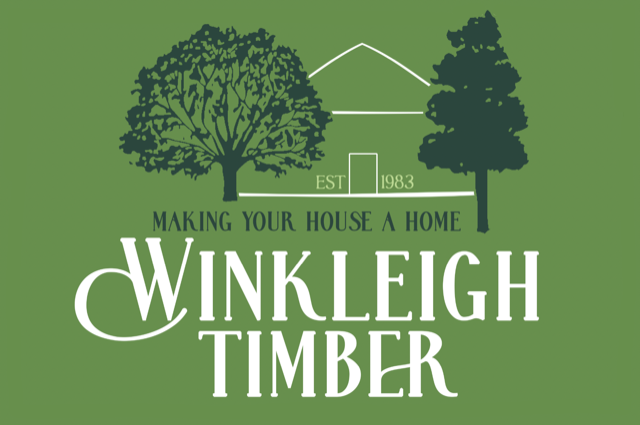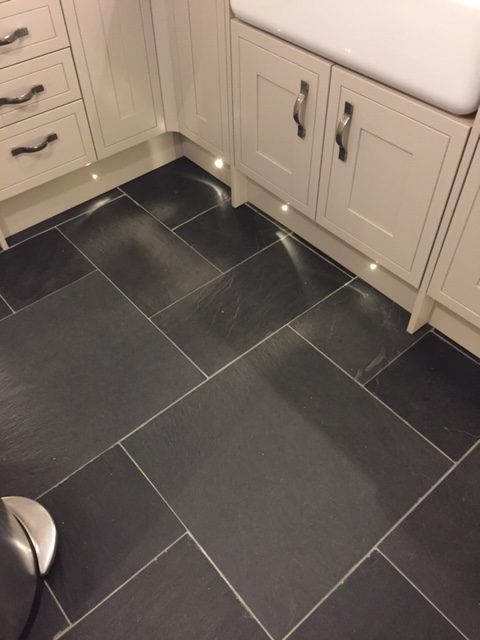When it comes to renovating a kitchen, one of the most critical decisions you’ll make is choosing the right flooring. The kitchen is a high-traffic area, subject to spills, stains, and heavy use, so the flooring material must be durable, easy to clean, while still looking great! Here, we’ll explore some of the best flooring materials for kitchens, examining their pros and cons to help you make the right choice.
Slate Flooring
Slate is a natural stone flooring material known for its durability and unique appearance. The dark grey-blue of slate makes it a versatile choice, offering a rustic and elegant look.
Pros of Slate Flooring
- Durability: Slate is incredibly durable and can withstand heavy foot traffic.
- Aesthetics: Its natural variation in colour and texture adds a unique, sophisticated touch to any kitchen.
- Water Resistance: Slate is resistant to water, making it an excellent choice for kitchens.
Cons of Slate Flooring
- Cost: Slate can be a more expensive option than some other materials.
- Maintenance: Slate requires sealing to prevent stains and damage.
Granite Flooring
Granite flooring is another natural stone option, renowned for its hard-wearing nature and beautiful, speckled appearance. Available in a variety of colours, granite can add a luxurious feel to your kitchen.
Pros of Granite Flooring
- Durability: Granite is one of the hardest natural stones available, making it extremely durable.
- Heat Resistance: Granite is resistant to heat, which is very beneficial in a kitchen.
- Variety: Comes in a range of colours and patterns to suit different home decors.
- Water resistance: Once sealed, granite is very water resistant, meaning the longevity of the floor won’t be compromised by spills.
Cons of Granite Flooring
- Cost: Similar to slate, granite is a natural material, making it slightly more expensive.
- Slipperiness: When wet, granite can be slippery, posing a hazard in the kitchen, however, this can be avoided by cleaning up any spills as they happen.
Terracotta Flooring
Terracotta tiles are made from natural clay and have a warm, rustic appeal. They are typically available in earthy tones, adding a cosy atmosphere to your kitchen.
Pros of Terracotta Flooring
- Aesthetic Appeal: The warm tones of terracotta create a welcoming and rustic look.
- Comfort: Softer and warmer underfoot compared to stone.
Cons of Terracotta Flooring
- Porosity: Terracotta is porous and needs to be sealed to prevent staining.
- Durability: It is less durable compared to other stone options and can chip or crack.
Sandstone Flooring
Sandstone is a sedimentary rock known for its natural beauty and varied colour palette. It’s softer than other stones, which makes it more comfortable to walk on.
Pros of Sandstone Flooring
- Natural Beauty: Sandstone has a warm, natural look that complements many kitchen styles.
- Versatility: Sandstone is available in a range of different tones, so you will be able to find a style that suits your home decor.
- Comfort: Softer and more forgiving underfoot than slate or granite.
Cons of Sandstone Flooring
- Maintenance: Requires sealing to protect against stains and moisture.
- Durability: Less durable than granite or slate and can wear down over time.
Engineered Oak Flooring
Engineered oak flooring consists of a top layer of real oak attached to a plywood base. It combines the beauty of natural wood with enhanced stability and resistance to moisture.
Pros of Engineered Oak Flooring
- Stability: More resistant to moisture and temperature changes than solid wood.
- Appearance: Offers the same attractive look as solid oak.
- Installation: Easier to install than solid wood and natural stone.
Cons of Engineered Oak Flooring
- Scratch Resistance: While durable, it can still scratch more easily than stone.
Solid Oak Flooring
Solid oak flooring is made from planks of oak wood. It is known for its timeless beauty and durability, adding a classic touch to any kitchen.
Pros of Solid Oak Flooring
- Durability: Extremely durable and long-lasting.
- Refinishing: Can be sanded and refinished multiple times, extending its lifespan.
- Aesthetic Appeal: Adds a warm, classic look to the kitchen.
Cons of Solid Oak Flooring
- Cost: Solid oak has a higher initial cost than some other flooring materials, but its longevity and ability to be refinished offset this cost over time.
- Maintenance: Requires regular maintenance to keep it looking its best.
Pine Flooring
Pine flooring is a softer wood option known for its charming, rustic appearance. It has a distinctive grain pattern and is typically less expensive than oak.
Pros of Pine Flooring
- Affordability: Generally less expensive than oak or engineered wood.
- Aesthetic: Offers a warm, rustic charm.
- Ease of Installation: Easier to install compared to harder woods.
Cons of Pine Flooring
- Durability: Softer than oak, it can scratch more easily.
- Maintenance: Needs sealing and maintenance.
Choosing the right kitchen flooring depends on your budget and style preferences. Slate and granite are excellent for durability and aesthetics but come with a higher price tag and maintenance needs. Engineered oak offers a balance of beauty and practicality, while pine and terracotta provide rustic charm at a lower cost but require more upkeep.
If you are feeling inspired, you can view our full range of flooring options here.
Back to news

